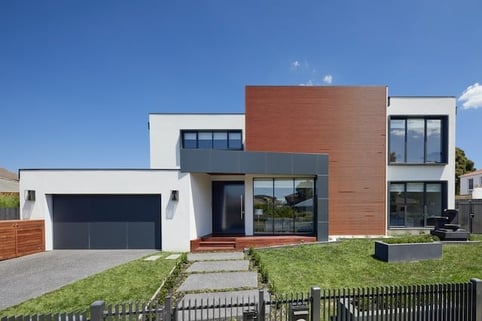
If you’re a homeowner with a modern sense of style, a flat roof could give you the aesthetic you’re looking for. It’s important to be aware, however, that without proper drainage, flat roofs can be very vulnerable to water damage. While a flat roof isn’t completely flat, slanting very slightly toward the roof drains to help with drainage, that slight slant isn’t enough to fully protect the structure from water damage. For this reason, flat roofs require an additional drainage system.
Types of Drainage Systems
There are several types of drainage systems available for flat roofs. The most common choices include inner drains, scuppers, gutters, and siphonic roof drains.
Inner Drains
Commonly found on commercial properties, inner drains are installed within the roof or inside the parapet wall (the small wall or railing around the edge of the roof). This placement prevents drainage pipes from hindering the building’s aesthetic. Inner drains can greatly decrease the risk of water damage to a flat roof because the pipes are underneath the roof and have little contact with the roof itself. However, it’s important to note that installation, maintenance, and repair of inner drains can cost more than other drainage systems, and if the drains become clogged or damaged, it can lead to water damage to the walls around the pipes.
Scuppers
Scuppers are simply large openings in a building’s outer wall that let water flow from the edge of the roof through downspouts that are installed below. The downspouts help guide water away from the walls to prevent damage. Scuppers are easy to maintain, and their wide openings prevent clogs. However, it is very important to check downspouts, which are susceptible to clogging, on a regular basis and clear any debris to avoid water backup within the spout.
Gutters
Gutters are common on many types of roofs and are a good option for flat roof systems. They are usually installed along the edges of the roof to direct water to a pipe or a downspout. Water should flow easily to the gutter as long as the roof tilts slightly in its direction. Gutters are often the most cost-effective option for smaller buildings. Like other drainage systems, however, gutters are susceptible to damage and clogging. Unless covered, they are completely open to the elements, allowing leaves, twigs, and other debris to block the flow of water. If you choose a gutter drainage system, just be sure to keep up on all regular maintenance and cleaning.
Siphonic Roof Drain
A siphonic roof drainage system is perfect for larger flat roofs that have to withstand heavy and frequent rain. With this system, a vacuum pump is used to remove water from the roof. The vacuum is connected to drain openings and rapidly draws water away from the flat roof’s surface. Siphonic drainage systems work quickly and efficiently and require little maintenance. Because the pipes used are small, it’s less intrusive and can leave more workspace around rooftop equipment like HVAC systems. Smaller pipes, however, also need to be cleaned more often to keep water flowing freely.
Importance of Proper Water Management
Installing a drainage system for your flat roof is crucial to prevent water damage and protect the health and safety of all who live or work there. Effective water management can help prevent water infiltration, damage, and mold and mildew growth in your building. After installing a good drainage system, scheduling regular maintenance for your flat roof will help it provide reliable protection for your building for many years to come. A small water leak can become a very big problem for a flat roof if it isn’t repaired as soon as possible. Have the roof inspected at least three times per year to check for pooling water, holes, or cracks, especially around the roof flashing and in seams. Also be sure to keep it clear of debris, which can easily collect on a flat roof.
If you have a flat roof, partner with a roofing professional like Hedrick Construction to keep it in top shape for as long as possible. Our expert technicians have extensive experience installing the right drainage systems for flat roofs, and we’re more than happy to help you decide what will work best for your building.
Subscribe to our blog for more roof maintenance advice!








Comments